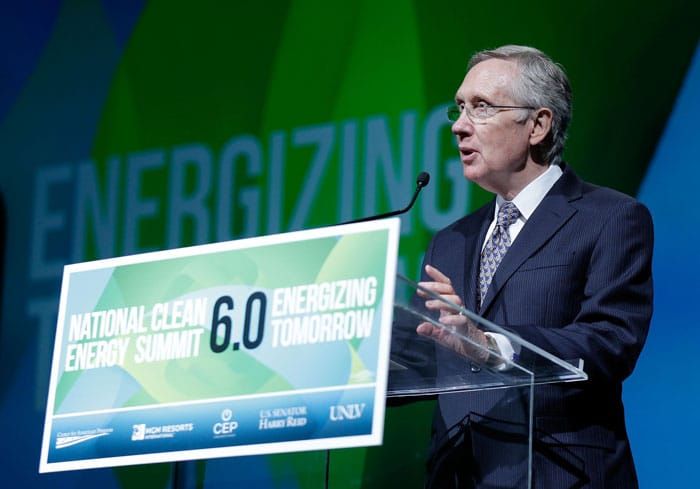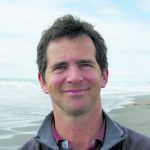Harry Reid’s lowercase “green new deal”
By Jon Christensen, Graham Chisholm | September 15, 2020
 Former US Sen. Harry Reid of Nevada in 2013, in Las Vegas. Photo by Isaac Brekken/Getty Images for National Clean Energy Summit 6.0.
Former US Sen. Harry Reid of Nevada in 2013, in Las Vegas. Photo by Isaac Brekken/Getty Images for National Clean Energy Summit 6.0.
A green new deal is emerging from the ground up in one of the most unlikely places in the country: Nevada. The leader at the center this new pragmatic environmental politics—unlikely as it may seem to observers outside the state—is former Sen. Harry Reid, who represented Nevada in Congress for 34 years.
During that time, Reid helped usher in some of the hallmark elements of what has come to be called a “green new deal.” He used federal stimulus money to support a just transition from fossil fuels to renewable energy and build a power grid for the future. He expanded public land protections and made the outdoors accessible to diverse urban residents. He settled a century-long water war with respect for Native American tribes and endangered species. At the same time, a booming gaming industry brought good-paying union jobs to the growing service economy in Las Vegas, transforming Nevada politically.
The New West and the Politics of the Environment, a feature-length documentary we helped produce for the public television environmental news magazine “Earth Focus,” makes the case for placing Reid and Nevada at the center of a lowercase green new deal struck in a politically purple region of the country.
When Reid retired, he donated his congressional papers to the University of Nevada, Reno. As the first researchers to have access to the papers, we discovered that at least half of them dealt with the environment. But when we asked Reid if he had a grand vision for a new environmental politics, he said, “Not at all.” He just did what needed to be done, what could be done, one step at a time.
That’s why we distinguish between Reid’s efforts and the comprehensive, far-reaching, and frankly left-leaning Green New Deal proposed in Congress by Rep. Alexandria Ocasio-Cortez, Sen. Ed Markey, and others. If the Democrats take control of the White House and Congress, as some observers now believe possible, there will be urgent calls for rapid and radical action. The Green New Deal will be pushed to the center of the debate. We believe a lowercase green new deal would be a better strategy even if the Democrats win—and especially if they don’t and need to govern with a divided government.
Reid’s legacy in Nevada offers lessons for crafting a green new deal that avoids the overreach and backlash that we’ve already seen in reaction to the Green New Deal, especially in purple states. Pragmatic approaches in Nevada and in other western states strongly suggest that states should be given room to work as laboratories of democracy, as Supreme Court Chief Justice Louis Brandeis suggested they could be during the Depression. This approach also provides opportunities to build constituencies in purple states for change over time.
So how do the “Green New Deal” and “green new deal” compare?
They share a commitment to a just energy transition, protecting vulnerable populations from pollution, and conserving public lands while enabling equitable access to the outdoors, economic stimulus, and good-paying jobs.
But the “Green New Deal” is radically aspirational. It wants to achieve net-zero greenhouse gas emissions in 10 years, while creating millions of high-wage jobs, investing in infrastructure and industry, promoting justice and equity, and securing clean air and water as well as climate and community resilience, healthy food, access to nature, and a sustainable environment for all. Oh yes, and provide everyone with high-quality health care, affordable housing, and a guaranteed job.
The “green new deal” is, admittedly, less ambitious—but more flexible. States are already implementing this green new deal: Thirty-four states, including Nevada, are implementing between five and 12 of the 30 state-level mitigation-related activities identified by the US Global Change Research Program in the National Climate Assessment it delivered to Congress and the President last year. There are outliers, like California, which are going all in with 25 strategies, but every state is doing something. Some cities, such as Los Angeles, have their own “Green New Deal,” and 455 cities across the country have their own emission reduction targets, as do 20 states.
This variation shows that there is ground to build on across the country, but also that the politics are different in different states. What works in California may not work in Nebraska or Iowa or even Nevada. In some states, it probably makes good sense to steer clear of any “green new deal” language. In Nebraska, for instance, the state Legislature has consistently opposed funding climate change research, but they care deeply about how changing weather patterns, drought, and flooding affect farming.
Americans should be politically savvy enough to see this and support the transitions that will help build the constituencies for green new deals, by whatever name. The House Select Committee on the Climate Crisis seems to understand this pragmatic approach. It recently released a “Climate Crisis Action Plan” that lays out nearly 100 strategies for achieving net-zero emissions and the other broad goals of a green new deal by 2050. The Senate Democrats’ Special Committee on the Climate Crisis released an equally ambitious political road map that is ready for use if they take power.
By our count, Nevada has begun implementing only 17 of the House strategies so far. The work of the green new deal is clearly unfinished, even in Nevada. So there is more to be done, including crafting a strategic vision for success. That strategic vision must leave room for a diversity of strategies to succeed – including those modeled by Harry Reid.
Editor’s note: Reid will participate in a special virtual screening premiere of The New West and the Politics of the Environment and a question and answer session on September 22 from 4 p.m. to 5 p.m., Pacific time. To register for the virtual event, visit: TheNewWest.eventbrite.com. The documentary will air in Southern California on Sept. 29 at 8 p.m. Pacific time on KCET and Thursday Oct. 1 at 9 p.m. Pacific on PBS SoCal. National air dates kick off September 30 at 9 p.m. Eastern time on Link TV nationwide (DirecTV 375 and DISH Network 9410), as well as on October 4 at 3:30 p.m. Eastern on the WORLD Channel . The documentary will also stream on http://kcet.org/thenewwest and the PBS app.
Together, we make the world safer.
The Bulletin elevates expert voices above the noise. But as an independent nonprofit organization, our operations depend on the support of readers like you. Help us continue to deliver quality journalism that holds leaders accountable. Your support of our work at any level is important. In return, we promise our coverage will be understandable, influential, vigilant, solution-oriented, and fair-minded. Together we can make a difference.
Keywords: New West environmentalism, climate chage, lowercase green new deal
Topics: Climate Change
















